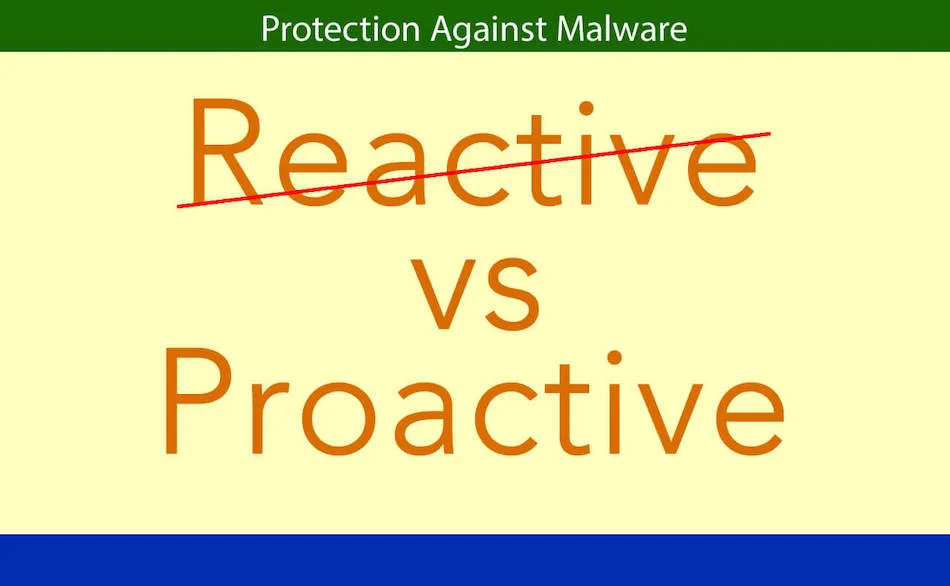Reactive vs Proactive Malware Protection – The Difference

What is the Difference Between Reactive and Proactive Malware Protection?
Malware is a constant threat online across devices and platforms. Websites, emails, and software may harbor an eclectic mix of malware ranging from ad-spammers to system-breaking ransomware.
Some of these are blatantly obvious, but others are insidious and infiltrate your system quietly. They hide in files, behind links, and in apparently safe web pages.
The only way to stay safe online is to use malware protection, in addition to an up-to-date antivirus. But anti-malware solutions are not equally effective. Perhaps the most important difference is whether they provide reactive or proactive protection.
Learn more about these different protection strategies to make an informed decision.
Reactive Malware Protection
Security solutions document and classify malware using published signature detection. Anti-malware solutions use a cybersecurity database to keep track of malware and check whether suspected files conform to existing malware threats.
Malware often exploits existing software and network security vulnerabilities. To counter this, reactive malware protection uses on-demand malware detection. This may include a real-time shield that defends your system from malware threats while you surf the web, check your inbox, or download files.
It’s important to remember that the quality of the reactive malware protection you get depends on the solution you’re using. A solution with a slowly-updating database may miss newer forms of malware.
What’s more, many anti-malware tools can detect threats but don’t have the functionality to contain and delete them. Instead, they simply point out the suspected file and ask you to delete it manually, which is not always sufficient to contain a threat.
On a basic level, reactive malware protection is essential to keeping your computer safe. Without it, malware may infect your system without being noticed. It may steal your data, slow down your system, track your activity, and even lock your files away and demand a ransom in return.
Reactive malware is indispensable to staying safe online.
Good to know:
- Reactive protection is only as good as the malware database against which it checks threats.
- The best reactive protection can not only identify threats but also remove them.
- Surfing the web without reactive protection exposes you to many risks.
- Reactive protection can protect you from trojans, spyware, ransomware, worms, and more.
Proactive Malware Protection
Proactive malware protection safeguards your system from threats in real time as well. But it goes a step further. It uses malware behavior-monitoring strategies including heuristic detection algorithms to identify suspicious files and bits of code that haven’t been classified as malware yet.
That’s important when you think that the AV-Test Institute alone registers daily over 350,000 new malware and potentially unwanted applications. Even the most comprehensive and frequently updated malware database is always at least a few minutes behind registering new threats. Often, threats are not identified until they have spread and affected a significant number of users. That is, days after their creation.
Protecting against malware signatures then is not enough. Proactive protection adds value to your anti-malware solution and increases the overall security of your system. By recognizing malware behavior, it can spot and quarantine threats before they have the chance to gain a foothold on your device or spread across your network.
But what about false alarms? Proactive malware protection may occasionally trigger false alarms, it’s true. In most cases, this means a pop-up notification that calls your attention to the file or link in question. However, when you consider the advantages of proactive malware detection, the false alarms are not a big problem.
Good to know:
- Proactive protection uses detection algorithms to discover suspicious malware behavior.
- Many anti-malware solutions don’t include proactive protection, leaving your system vulnerable to emerging threats.
- Proactive protection must provide real-time browser and email protection to be effective.
- The investment in proactive malware protection pays off in time and can help you save money on purging infected systems and recovering your data, which is generally much more expensive.
Reactive Versus Proactive Malware Protection – Which Should You Choose?
Reactive malware protection is better than no protection, but it’s not discerning enough to safeguard your system from new threats. That’s where proactive protection comes in. However, proactive protection on its own is not ideal for dealing with well-documented malware as it may use more resources and take longer to identify it than a reactive defense.
The good news here is that you don’t have to choose. A good malware protection solution combines reactive with proactive protection to defend your computer against existing as well as emerging threats. It brings together the effective malware identification and removal tools of reactive protection with the quick discovery and detection of proactive tools.
A good example of reactive and proactive protection in action is the System Shield built into the System Mechanic Ultimate Defense security solution. It uses VB100-certified protection to deploy reactive and proactive malware detection strategies that stop threats before they can steal data, slow system performance, or damage files.
The bottom line – use both reactive and proactive malware defenses to keep your system safe.
References:
